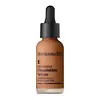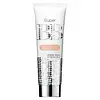Perricone MD No Makeup Foundation Serum Broad Spectrum SPF 20 Versus Physician's Formula Super BB All-in-1 Beauty Balm Cream
What's inside
What's inside
 Key Ingredients
Key Ingredients

 Benefits
Benefits

 Concerns
Concerns

 Ingredients Side-by-side
Ingredients Side-by-side

Cyclopentasiloxane
EmollientWater
Skin ConditioningButyloctyl Salicylate
Skin ConditioningTriheptanoin
Skin ConditioningAcrylates Copolymer
Dimethicone
EmollientC13-16 Isoparaffin
SolventAlcohol Denat.
AntimicrobialButylene Glycol
HumectantPEG-9 Polydimethylsiloxyethyl Dimethicone
EmulsifyingC12-15 Alkyl Benzoate
AntimicrobialIsododecane
EmollientSilica
AbrasiveGlycerin
HumectantBellis Perennis Flower Extract
Skin ConditioningHdi/Trimethylol Hexyllactone Crosspolymer
Dimethicone/PEG-10/15 Crosspolymer
Quaternium-90 Bentonite
Sodium Chloride
MaskingAcetyl Tetrapeptide-9
Skin ConditioningPalmitoyl Tripeptide-1
Skin ConditioningPalmitoyl Tetrapeptide-7
Skin ConditioningArgania Spinosa Kernel Oil
EmollientTocopheryl Acetate
AntioxidantXanthan Gum
EmulsifyingBisabolol
MaskingTocopherol
AntioxidantDisodium EDTA
Mannitol
HumectantDisodium Phosphate
BufferingPotassium Phosphate
BufferingTriceteareth-4 Phosphate
EmulsifyingCetyl PEG/PPG-10/1 Dimethicone
EmulsifyingPolyglyceryl-3 Diisostearate
EmulsifyingPolyglyceryl-6 Polyricinoleate
EmulsifyingCaprylyl Glycol
EmollientDimethicone/Vinyl Dimethicone Crosspolymer
Skin ConditioningPropylene Carbonate
SolventSorbitan Laurate
EmulsifyingTriethoxycaprylylsilane
Octyldodecanol
EmollientC18-36 Acid Glycol Ester
EmollientC18-36 Acid Triglyceride
EmollientHexylene Glycol
EmulsifyingDipropylene Glycol
HumectantSodium Citrate
BufferingPotassium Chloride
Phenoxyethanol
PreservativePotassium Sorbate
PreservativePhenethyl Alcohol
MaskingCI 77891
Cosmetic ColorantIron Oxides
Cyclopentasiloxane, Water, Butyloctyl Salicylate, Triheptanoin, Acrylates Copolymer, Dimethicone, C13-16 Isoparaffin, Alcohol Denat., Butylene Glycol, PEG-9 Polydimethylsiloxyethyl Dimethicone, C12-15 Alkyl Benzoate, Isododecane, Silica, Glycerin, Bellis Perennis Flower Extract, Hdi/Trimethylol Hexyllactone Crosspolymer, Dimethicone/PEG-10/15 Crosspolymer, Quaternium-90 Bentonite, Sodium Chloride, Acetyl Tetrapeptide-9, Palmitoyl Tripeptide-1, Palmitoyl Tetrapeptide-7, Argania Spinosa Kernel Oil, Tocopheryl Acetate, Xanthan Gum, Bisabolol, Tocopherol, Disodium EDTA, Mannitol, Disodium Phosphate, Potassium Phosphate, Triceteareth-4 Phosphate, Cetyl PEG/PPG-10/1 Dimethicone, Polyglyceryl-3 Diisostearate, Polyglyceryl-6 Polyricinoleate, Caprylyl Glycol, Dimethicone/Vinyl Dimethicone Crosspolymer, Propylene Carbonate, Sorbitan Laurate, Triethoxycaprylylsilane, Octyldodecanol, C18-36 Acid Glycol Ester, C18-36 Acid Triglyceride, Hexylene Glycol, Dipropylene Glycol, Sodium Citrate, Potassium Chloride, Phenoxyethanol, Potassium Sorbate, Phenethyl Alcohol, CI 77891, Iron Oxides
Titanium Dioxide
Cosmetic ColorantZinc Oxide
Cosmetic ColorantWater
Skin ConditioningCyclopentasiloxane
EmollientCaprylic/Capric Triglyceride
MaskingNeopentyl Glycol Diheptanoate
EmollientDimethicone
EmollientButylene Glycol
HumectantCetyl PEG/PPG-10/1 Dimethicone
EmulsifyingCetearyl Alcohol
EmollientC30-45 Alkyl Cetearyl Dimethicone Crosspolymer
EmollientPEG-10 Dimethicone
Skin ConditioningSodium Chloride
MaskingGlycerin
HumectantSalix Alba Bark Extract
AstringentButyrospermum Parkii Butter
Skin ConditioningPerilla Ocymoides Seed Oil
Skin ConditioningLysolecithin
EmulsifyingPolysilicone-11
Tetrahexyldecyl Ascorbate
AntioxidantTocopheryl Acetate
AntioxidantDisodium EDTA
Disteardimonium Hectorite
StabilisingGlyceryl Stearate
EmollientLaureth-12
EmulsifyingMagnesium Silicate
AbsorbentMica
Cosmetic ColorantPEG/PPG-18/18 Dimethicone
EmulsifyingPolysorbate 60
EmulsifyingPropylene Carbonate
SolventSodium Hydroxide
BufferingTriethoxycaprylylsilane
Xanthan Gum
EmulsifyingCaprylyl Glycol
EmollientEthylhexylglycerin
Skin ConditioningHexylene Glycol
EmulsifyingPhenoxyethanol
PreservativeTitanium Dioxide, Zinc Oxide, Water, Cyclopentasiloxane, Caprylic/Capric Triglyceride, Neopentyl Glycol Diheptanoate, Dimethicone, Butylene Glycol, Cetyl PEG/PPG-10/1 Dimethicone, Cetearyl Alcohol, C30-45 Alkyl Cetearyl Dimethicone Crosspolymer, PEG-10 Dimethicone, Sodium Chloride, Glycerin, Salix Alba Bark Extract, Butyrospermum Parkii Butter, Perilla Ocymoides Seed Oil, Lysolecithin, Polysilicone-11, Tetrahexyldecyl Ascorbate, Tocopheryl Acetate, Disodium EDTA, Disteardimonium Hectorite, Glyceryl Stearate, Laureth-12, Magnesium Silicate, Mica, PEG/PPG-18/18 Dimethicone, Polysorbate 60, Propylene Carbonate, Sodium Hydroxide, Triethoxycaprylylsilane, Xanthan Gum, Caprylyl Glycol, Ethylhexylglycerin, Hexylene Glycol, Phenoxyethanol
Ingredients Explained
These ingredients are found in both products.
Ingredients higher up in an ingredient list are typically present in a larger amount.
Butylene Glycol (or BG) is used within cosmetic products for a few different reasons:
Overall, Butylene Glycol is a safe and well-rounded ingredient that works well with other ingredients.
Though this ingredient works well with most skin types, some people with sensitive skin may experience a reaction such as allergic rashes, closed comedones, or itchiness.
Learn more about Butylene GlycolCaprylyl Glycol is a humectant and emollient, meaning it attracts and preserves moisture.
It is a common ingredient in many products, especially those designed to hydrate skin. The primary benefits are retaining moisture, skin softening, and promoting a healthy skin barrier.
Though Caprylyl Glycol is an alcohol derived from fatty acids, it is not the kind that can dry out skin.
This ingredient is also used as a preservative to extend the life of products. It has slight antimicrobial properties.
Learn more about Caprylyl GlycolThis ingredient is a high molecular weight silicone. It has emulsifying and skin conditioning properties.
Cyclopentasiloxane, or D5, is a silicone used to improve texture of products and trap moisture.
D5 is considered lightweight and volatile. Volatile means it evaporates quickly after application. Once evaporated, D5 leaves a thin barrier that helps keep skin hydrated.
It is also an emollient. Emollients help soften the skin and prevent water loss. Silicones create a silky texture in products. D5 helps other ingredients become more spreadable.
Studies show D5 is safe to use in skincare products. We recommend speaking with a skincare professional if you have concerns.
Learn more about CyclopentasiloxaneDimethicone is a type of synthetic silicone created from natural materials such as quartz.
What it does:
Dimethicone comes in different viscosities:
Depending on the viscosity, dimethicone has different properties.
Ingredients lists don't always show which type is used, so we recommend reaching out to the brand if you have questions about the viscosity.
This ingredient is unlikely to cause irritation because it does not get absorbed into skin. However, people with silicone allergies should be careful about using this ingredient.
Note: Dimethicone may contribute to pilling. This is because it is not oil or water soluble, so pilling may occur when layered with products. When mixed with heavy oils in a formula, the outcome is also quite greasy.
Learn more about DimethiconeDisodium EDTA plays a role in making products more stable by aiding other preservatives.
It is a chelating agent, meaning it neutralizes metal ions that may be found in a product.
Disodium EDTA is a salt of edetic acid and is found to be safe in cosmetic ingredients.
Learn more about Disodium EDTAGlycerin is already naturally found in your skin. It helps moisturize and protect your skin.
A study from 2016 found glycerin to be more effective as a humectant than AHAs and hyaluronic acid.
As a humectant, it helps the skin stay hydrated by pulling moisture to your skin. The low molecular weight of glycerin allows it to pull moisture into the deeper layers of your skin.
Hydrated skin improves your skin barrier; Your skin barrier helps protect against irritants and bacteria.
Glycerin has also been found to have antimicrobial and antiviral properties. Due to these properties, glycerin is often used in wound and burn treatments.
In cosmetics, glycerin is usually derived from plants such as soybean or palm. However, it can also be sourced from animals, such as tallow or animal fat.
This ingredient is organic, colorless, odorless, and non-toxic.
Glycerin is the name for this ingredient in American English. British English uses Glycerol/Glycerine.
Learn more about GlycerinHexylene Glycol is a surfactant. Glycols are a class of alcohols. Hexylene Glycol is a surfactant and emulsifier.
As a surfactant, Hexylene Glycol helps gather dirt and oil on your skin to be washed away.
As an emulsifier, Hexylene Glycol helps keep water and oil together. This prevents them from separating in a product. Hexylene Glycol also thins out the texture of a product by lessening viscosity.
Hexylene Glycol has a small molecular weight.
Learn more about Hexylene GlycolPhenoxyethanol is a preservative that has germicide, antimicrobial, and aromatic properties. Studies show that phenoxyethanol can prevent microbial growth. By itself, it has a scent that is similar to that of a rose.
It's often used in formulations along with Caprylyl Glycol to preserve the shelf life of products.
This ingredient is a solvent. It helps dissolve active ingredients and alter the texture of products.
Propylene Carbonate is commonly used in makeup and with clay, such as montmorillonite or bentonite.
Studies show this ingredient to be safe for cosmetics. When it is undiluted, it can cause skin irritation. (It is always diluted in skincare and makeup). This ingredient is water-soluble.
Propylene Carbonate is created from propylene glycol and carbonic acid.
Learn more about Propylene CarbonateChances are, you eat sodium chloride every day. Sodium Chloride is also known as table salt.
This ingredient has many purposes in skincare: thickener, emulsifier, and exfoliator.
You'll most likely find this ingredient in cleansers where it is used to create a gel-like texture. As an emulsifier, it also prevents ingredients from separating.
There is much debate on whether this ingredient is comedogenic. The short answer - comedogenic ratings don't tell the whole story. Learn more about comegodenic ratings here.
The concensus about this ingredient causing acne seems to be divided. Research is needed to understand if this ingredient does cause acne.
Scrubs may use salt as the primary exfoliating ingredient.
Learn more about Sodium ChlorideTocopheryl Acetate is AKA Vitamin E. It is an antioxidant and protects your skin from free radicals. Free radicals damage the skin by breaking down collagen.
One study found using Tocopheryl Acetate with Vitamin C decreased the number of sunburned cells.
Tocopheryl Acetate is commonly found in both skincare and dietary supplements.
Learn more about Tocopheryl AcetateTriethoxycaprylylsilane is a silicone used to bind and stabilize ingredients.
As an emulsifier, it helps prevent ingredients from separating. This can help elongate the shelf life of products.
Triethoxycaprylylsilane is often used to coat mineral sunscreens ingredients to help give a better feel. It also helps reduce oxidative stress in sunscreens.
Learn more about TriethoxycaprylylsilaneWater. It's the most common cosmetic ingredient of all. You'll usually see it at the top of ingredient lists, meaning that it makes up the largest part of the product.
So why is it so popular? Water most often acts as a solvent - this means that it helps dissolve other ingredients into the formulation.
You'll also recognize water as that liquid we all need to stay alive. If you see this, drink a glass of water. Stay hydrated!
Learn more about WaterXanthan gum is used as a stabilizer and thickener within cosmetic products. It helps give products a sticky, thick feeling - preventing them from being too runny.
On the technical side of things, xanthan gum is a polysaccharide - a combination consisting of multiple sugar molecules bonded together.
Xanthan gum is a pretty common and great ingredient. It is a natural, non-toxic, non-irritating ingredient that is also commonly used in food products.
Learn more about Xanthan Gum